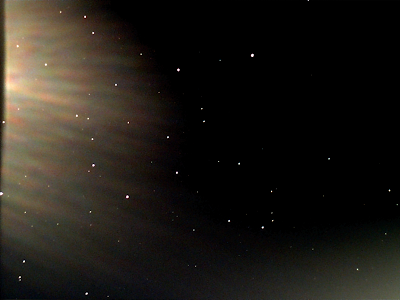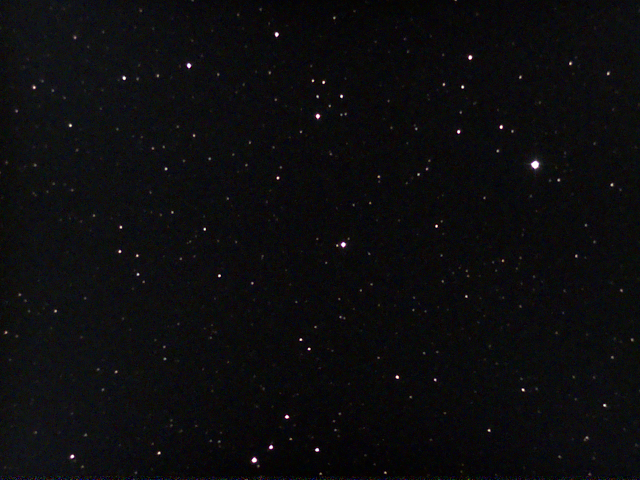Globular star clusters are collections a few hundred thousand old stars that are gravitationally bound together. There are 29 globular star clusters in the catalog of objects that might be mistaken for comets made by French comet hunter Charles Messier in the 1700s. Globular star clusters make up just over 26% of the the 110 on the list. Other objects in the Messier Catalog include open star clusters, nebulae, galaxies and a few odds and ends. It makes sense that globulars would be well represented as a globular star cluster can very much resemble a comet that does not have a tail.
Summer evenings in the Northern Hemisphere are the best time to see globular star clusters as so many of them are in the sky at once. Have a look at this image from the SkySafari app:
The graphic is just over 50 degrees wide and mainly shows the constellations of Sagittarius, Scorpius and Ophiuchus (alas, headless here). Marked on the image are the locations of 16 of the 29 (55%) globular star clusters on Messier’s list. Also marked on the image (up and right from the tip of the arrow of Sagittarius) is the location of Sagittarius A*, the black hole at the center of the Milky Way Galaxy. Sagittarius A* is invisible to our eyes and in optical telescopes, but it is no coincidence that so many globular star clusters are in the area surrounding the center of our galaxy. They are there because they are in orbit around the center of our galaxy.
Over the last several months I have used my Unistellar eVscope to photograph the Messier globulars. Here is a mosaic I made that shows the first 15 globulars in the catalog:

Row 1: Messier 2, 3, 4, 5, 9. Row 2: Messier 10, 12, 13, 14, 15. Row 3: Messier 19, 22, 28, 30, 53.
Here are the rest:

Row 1: M54, 55, 56, 62, 68. Row 2: M69, 70, 71, 72, 75. Row 3: M79, 80, 92, 107.
For some reason I initially felt it was necessary for me to rank the clusters, but as I got
started it began to seem like writing about each and every one of them
was a far more daunting task than observing them was. So instead, here are a few things that I think are interesting about some of them.
 |
| M107 |
M107 is the eighth closest globular star cluster in the Messier Catalog, yet it is the faintest of all 29. This cluster wasn’t officially added to the Messier list until 1947, some 130 years after Messier’s death. M107 was discovered by Pierre Méchain in 1782 a year after Messier compiled his “final” list. Méchain, who collaborated with Messier, often shared his discoveries with Messier who then confirmed them and then added them to his list. So why is M107 on the official list? Because it is, though if you ask me these late addition objects (M104 - 110) are on shaky ground. The cluster is not amazing and when combined with the dubious nature of it being on the list it ranks as my least favorite.
 |
| M3 |
M3 is 33,900 light years away in the direction of the constellation of Canes Venatici. It has half a million stars and is 90 light years across. M3 is one of the first globular star clusters to appear in the evening as summer season of globular star cluster observing begins.
 |
| M4 |
Located just over a degree west of the bright star Antares in Scorpius makes M4 an easy target to find in the sky. The cluster is relatively close to us with a distance of just 7,200 light years. It is 75 light years across and has just 44,000 stars, which is kind of low for a globular star cluster. Clouds of interstellar dust lie between us and M4. The dust gives it a distinct orange color and if the dust weren’t there M4 would be much brighter in our skies, as it is it is it is the third brightest on the list.
 |
| M13 |
M13 is widely considered the best globular star cluster of the bunch. It is often referred to as the “Great Hercules Cluster.” What makes it so great? It is the 2nd brightest of the globular star clusters in the Messier catalog. It is also the 2nd most northern of the globulars, putting it much higher in the sky for observers in the Northern Hemisphere. It’s not amazingly close, in fact it is some 22,000 light years away from us. Unrelated, but back in 1974 the now defunct Arecibo radio telescope was used to beam a brief message (the most powerful signal ever sent from Earth) to this cluster. Finally, M13 is an easy target to find because of its location in the “Keystone” asterism within the constellation of Hercules. Is it the best globular on the list? Almost.
 |
| M15 |
M15 is 33,600 light years away from our Solar System. It is seen in the direction of the constellation of Pegasus, which makes it one of the few globular clusters to see in fall evenings (for observers in the Northern Hemisphere). It sports an intermediate mass black hole at its core which weighs in at 4,000 times the mass of our Sun.
 |
| M22 |
At a distance of around 10,000 light years M22 is the 2nd closest of the globular star clusters. It is 97 light years across and shines with a brightness of over 200,000 Suns. It’s visual magnitude is 5.1, making it the brightest of the Messier globular star clusters (Two other globular star clusters are brighter, but they are located too far south for Messier to have observed them). Like M4, there’s dust between us and the cluster, so it would be even brighter if the dust were not obscuring some of its light. Still, it is a beautiful looking star cluster. For most people it loses points for being so far south in the sky, but M22 more than makes up for it by looking so great and giving us stars all the way down to its center.


Above is a screen grab from SkySafari showing the location of M54 and at right is an image of it. It isn't an impressive globular star cluster, unless you know its story. M54 lies some 87,000 light years from our Solar System, making it the most distant globular on the list by a whopping 20,000 light years! In fact you could even say that M54 is extra galactic, as in it doesn’t even belong to our galaxy, the Milky Way, making it the only globular in the Messier Catalog that lies outside of our galaxy. It belongs to the faint Sagittarius Dwarf Elliptical Galaxy (SDEG). The SDEG is the big (7.5 degrees in length) oval in the image above left. It is possible that M54 might be the core of the SDEG instead of a true globular star cluster. There’s evidence that there’s a black hole at its core. It is one of the most luminous globular star clusters known, shining with a brilliance 850,000x times that of the Sun. There’s just one globular star cluster that exceeds that, Omega Centauri, a cluster too far south for Messier to have seen.
 |
| M55 |
Finally, here's M55. For some reason M55 is one of those star clusters that I tend to forget about, but it is a really nice one. It is one of the seven Messier globulars in Sagittarius. It lies 17,600 light years away and it a beautiful sight to see.
I could go on, but I think that perhaps instead I'll start planning my next observing session.





















































